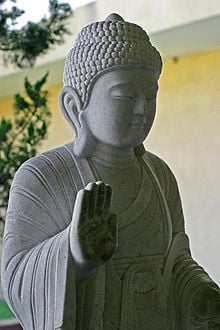Tathagata
Tathāgata (Pali and Sanskrit. "one who has thus gone" - tathā-gata; "one who has thus come" - tathā-āgata; or " one who has gone to That", Tat-āgata; pron: taaht-āhgatah) (ch.如來)(jp. 如来) is the name which the historical Buddha Gautama used when referring to himself[1] . The term is deliberately ambiguous, reflecting the ineffable ontological status of a fully liberated human being. Some would say that such a one has attained True Being (Sat) ; others that the liberated soul has transcended categories of being and non-being. Thus tathāgata reflects these ambiguities having no fixed meaning. Gautama Buddha used this word as his preferred personal appellation. In the scriptures instead of saying 'me' or 'myself' he says, "The tathagata is such and such..." emphasising that as an enlightened being he has gone beyond human personality - the absence of self being a central doctrine of Gautama Buddha's teaching.
Etymology
One etymological interpretation of Tathagata is that its two parts are composed of Tat and āgata. Tat has from time immemorial in India, meant Brahman, the Absolute, as in the famous Upanishadic dictum: “That (Brahman) thou art” (Tat tvam asi) from the Chandogya Upanishad, a widely discussed spiritual document in the time of the Buddha. “That” here refers to Brahman, the Godhead, the ultimate Subject of Selfhood which the muni, or sage, has reached at the pinnacle of his having fulfilled wisdom’s perfection.
Āgata is the past tense denotation of gata (going, traveling, trekking), here being meant “arrival, gone-unto, attainment of, arrival-at”. As such, Tathagata in the ancient Prakrit Pali, means literally “(The sage who has) arrived at the Absolute”.
The term Tathagata is thus none other than a personal appellation of that very rare someone who has realized by experiential wisdom “tat tvam asi”.
As [It 57] and other passages clearly show, “become-Brahman” is the meaning of the term Tathagata, or he who has arrived (agata), again being meant the transfiguration and assimilation of the mind (citta) in upon itself (bhava), and thereby achieving the Absolute, i.e. Brahman, as such (brahmabhutam tathagata) is said.
Scriptural collaboration of same: (Tathagatassa hetam, adhivacanam brahmabhuto itipi)-“The Tathagata means 'the body of Brahman', 'become Brahman'” [DN 3.84]. (brahmabhutam tathagata)-“Become-Brahman is the meaning of Tathagata” [It 57]
Other interpretations
In the Dhammapada, the actions of an arahant are described as without trace (ananuvejja) or 'trackless' (apada) 'like the birds in the sky' (ākāse'va sakuntānam gati tesam durannayā[2]). Similarly in the Mahabharata there is a verse which says: 'Just as the footprint of birds flying in the sky and of fish swimming in the water may not be seen, so is the going of those who have realised the truth' (tathā jñānavidam gatih), Śāntiparva 181. 12. Tathāgata therefore evokes this indefinable, ineffable quality of one who has arrived at the truth.
Another common interpretation is that tathāgata means 'one who comes and goes' (in the same manner as all the Buddhas). This understanding comes from early Buddhist mythology where the Buddha is considered a teacher come from the Tusita heaven (satthā Tusita gani-m-āgata - Sutta Nipāta 5. 955
Notes
- ↑ Nyanatiloka, Buddhist Dictionary. Accessed online at: budsas.org (October 16, 2007).
- ↑ Dhammapada.verse,92
ReferencesISBN links support NWE through referral fees
- Coomaraswamy, Ananda K. "Tathāgata." Bulletin of the School of Oriental Studies, University of London. 9:2 (1938). 331.
- Hopkins, E. Washburn. "Buddha as Tathagata." The American Journal of Philology. 32:2 (1911). 205-209.
- Nyanatiloka. Buddhist Dictionary: Manual of Buddhist Terms and Doctrines. San Francisco: Chinese Materials Center, 1977. Also available online at: budsas.org
- The Seeker's Glossary of Buddhism. Taiwan: The Corporate Body of the Buddha Educational Foundation, 1998.
- Shuhmacher, Stephan and Gert Woerner. The Encyclopedia of Eastern Philosophy and Religion: Buddhism, Hinduism, Taoism, Zen. Boston: Shambala, 1994.
- Thomas, E. J. "Tathāgata and Tahāgaya." Bulletin of the School of Oriental Studies, University of London, Vol. 8, No. 2/3, Indian and Iranian Studies: Presented to George Abraham Grierson on His Eighty-Fifth Birthday, 7th January, 1936. 781-788.
- Tokiwa, Gishin. "Chan (Zen) View of Suffering." Buddhist-Christian Studies 5 (1985). 103-129.
- Wayman, Alex. "The Tathāgata Chapter of Nāgārjuna's "Mūla-Madhyamaka-kārikā." Philosophy East and West 38:1 (January 1988). 47-57.
Credits
New World Encyclopedia writers and editors rewrote and completed the Wikipedia article in accordance with New World Encyclopedia standards. This article abides by terms of the Creative Commons CC-by-sa 3.0 License (CC-by-sa), which may be used and disseminated with proper attribution. Credit is due under the terms of this license that can reference both the New World Encyclopedia contributors and the selfless volunteer contributors of the Wikimedia Foundation. To cite this article click here for a list of acceptable citing formats.The history of earlier contributions by wikipedians is accessible to researchers here:
The history of this article since it was imported to New World Encyclopedia:
Note: Some restrictions may apply to use of individual images which are separately licensed.
